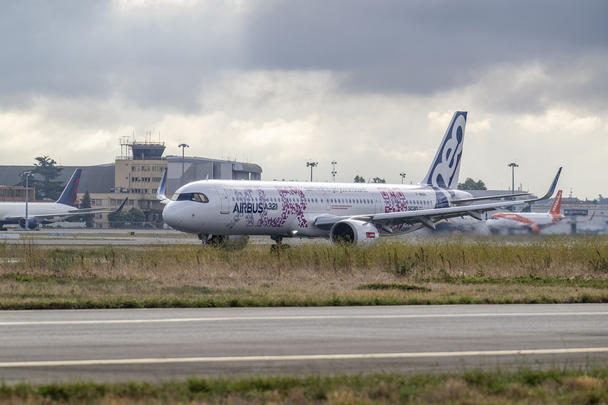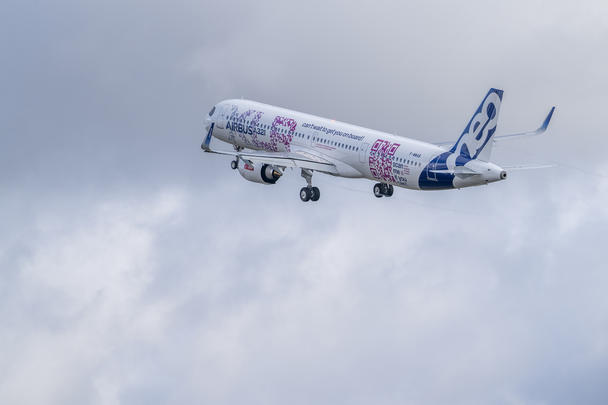The A321XLR program has just kicked-off an international flight-test campaign, known as ‘Functional and Reliability Testing’ (FnR). Also referred to as ‘Route Proving’, this is part of Airbus’ certification activity contributing to EASA Type Certification expected for the new variant in 2024.
Overall, the main objective of the FnR is to demonstrate the A321XLR’s systems maturity well before entry into service, with a target of approximately 100 hours flying time over 10 days with no systems power-down. Specific sectors, comprising around 15 flights in total, are intentionally typical of what airlines might fly when the aircraft enters service. These have been defined to represent a mix of operator profiles, climatic conditions, flight durations and airport turnaround times.
For the first time since the A321XLR first flew in June 2022, there will be real airline cabin and flight crews gaining hands-on experience, alongside the Airbus test pilots and flight engineers as well as a representative group of around 30 passengers made up of volunteer Airbus and airline employees. Everyone on board, as well as myriad supporting teams on the ground in Toulouse and also at the destination airports, will contribute to a common objective to provide valuable feedback as the A321XLR spreads its wings for the first time, crossing oceans and visiting international airports. The aircraft which is flying these missions is ‘MSN 11080’ – one of three dedicated flight test prototypes, and the only one which is equipped with a full cabin interior.
“In the olden days ‘route proving’ was very much about showing customers the aircraft in action – that the aircraft they have bought can actually do what they want to do with it,” recalls Jim Fawcett, Airbus’ Lead Flight Test Engineer for the A321XLR’s FnR exercise.
“These days we carry on with this kind of demonstration, but we’re also looking at showing the technical reliability and maturity and good functioning of the aircraft. So that’s why we prefer to call it ‘functional and reliability testing’.”
Mission drivers
There are several drivers, explains Fawcett. “One is a certification requirement and it’s actually written down in the EASA rules and regulations. While there are similar things on the FAA side, we’re getting an EASA type certificate to start off with, and this requires us to conduct 150 hours of flying which has to represent routine airline-like operations and do so safely under all normal dispatch conditions. Moreover, EASA recommends that this testing is undertaken working with an operator, in our case an airline.”

He adds: “The flying has to be done on a single aircraft, flying on a continuous schedule, and its configuration needs to be as close as possible to the final ‘Type’ design. This is why we perform this exercise in the second half of the overall certification campaign, as it allows us to have completed all the independent intermediate development cycles and thus have the latest software standards loaded.”
Furthermore, the operation should represent typical in-service ambient conditions. “We’re therefore looking to go somewhere a bit warm, and a bit cold – to different airfields in terms of their infrastructure, location, weather and runway altitudes. So if we can tick all of those boxes as well, then it makes it a much more representative demonstration,” says Fawcett.
Accelerating systems maturity
Complementing this certification-related activity, Airbus has also set itself additional requirements, which are all about improving the maturity of its systems. “We know from previous experience that sometimes we test and develop and certify systems which work fine on a short flight and over a short duration. But as soon as they get into regular service and they’re operated continuously for days on end, then some systems can succumb to ‘infant mortality’. Airlines can therefore experience early failures quickly, unsurprisingly, since they build-up many operational flight-hours and flight-cycles in a relatively short period of time.”
Fortunately, to address that issue, Airbus has set up an internal development activity called maturity testing – which is part of the rationale that the aircraft remains powered-on for the whole of the 10 days campaign window – which is quite representative of what happens in an airline operational environment. Moreover, the objective is not to do that in addition to the certification activity. The objective is to do them in parallel. “We’re not looking at doing 150 plus 100 hours. Rather, we’re looking at fulfilling a subset of those hours.”
Another key driver is the traditional ‘route proving’ exercise where Airbus has the opportunity to work early-on with its customers to show them that it will deliver what it had promised – and also to receive their very early feedback on what they think of the aircraft and benefit from their operational expertise.
Campaign structure
The first part of the maturity campaign involves the aircraft flying various trips of several hours each, from Toulouse and back to Toulouse – one of these will approach the North Pole and then circle-back to Toulouse, for example. Others will fly around Europe. The second part will explore transatlantic operations into and from a US gateway airport. Over the course of the 10 days there will be numerous airline and Airbus flight-crew changes in between the various sectors.
Crucial to the whole operation are also the ground crews – who will be pre-positioned at each end to ‘turn-around’ the aircraft as if it was in real airline service. “We will have maintenance teams provided by Airbus at each base,” notes Fawcett. “They will be working with our airline customers in terms of providing us with a fuel truck or a catering service or a water and waste servicing truck – all those kinds of things in just the same way as the airlines do on any of their rotations on any day of the week.”
In parallel, Airbus’ Maintenance Control Center (MCC) in Toulouse will be following the aircraft 24 hours a day. They will be able to identify upcoming maintenance issues because they can receive data directly from the aircraft by its standard ACARS data link, just as an airline would.

Post campaign feedback assessment phase
After the flights themselves are completed, the FnR campaign swings into its next phase which addresses the aspects of certification reporting as well as Airbus’ own internal development activity.
“For our certification obligation we will provide a report to EASA within two weeks of the end of the exercise, as we have to present the proof that we have completed the 150 hours which are needed for the regulation point of view. We also have to list any failures and that we were able to continue operating safely in accordance with our Master Minimum Equipment List (MMEL).”
He adds: “That’s one of the elements, which needs to go into the overall dossier for the type certification of the aircraft, then EASA will process all of the documentation for the certification flight test campaign.”
In terms of Airbus’ own internal development objectives related to the maturity campaign, there will be a great deal more retrospective assessment, not only from the customers’ observations and feedback, but also from the on-board Flight Test Instrumentation (FTI) recorded data that allows the engineers to see where systems have worked well or not, and to see what can be done to rectify any problems.
Notably, there will be a window of opportunity between when the aircraft is certified (Type Certification) and when the first customers use it (Entry Into Service – EIS) to further update the definition of the aircraft. As a result, the first aircraft to be delivered to the launch customers will benefit from any feedback which has been gleaned from the whole of the flight test campaign, not just from the FnR.
Designed to be operated just like a regular A321neo
A very practical and positive measure of the success arising from the campaign, would be if the crews and passengers on board, as well as the ground support teams, were to say that they see very little difference between operating an A321XLR and the regular A321neo.
“If our participants tell us that they see very little difference versus the A321s in current operation, then to be honest, Airbus as an organisation will have done our job,” emphasises Fawcett.
This would indeed align with the fact that many of the A321XLR’s changes are ‘behind-the-scenes’. “For example, it’s about making sure that the aircraft is capable of safely taking off at a higher weight than before,” says Fawcett. “This is possible thanks to some structural and aerodynamic control-surface optimisations – which in turn have required corresponding adaptations and re-tuning required for the flight control laws. The aircraft also features an uprated landing gear system, matched to the aircraft’s extra weight and rolling speeds, and without the ride being uncomfortable.”
Regarding the interior environment, whilst it may be based on the same Airspace cabin as for A321neos being delivered today, there are new behind-the-scenes changes – such as the thermal and acoustic insulation as well the ventilation and heating systems. These features have been enhanced especially for the -XLR since this variant will naturally spend longer at high altitudes for extended periods, compared with the regular A321neo.
“In a nutshell, during and following this exercise, what we really want our experts, our airline and airport partners and passengers to say is: ‘This aircraft is good. It’s exactly like what we know and it’s just giving us that extra boost of range that we needed.’ That’s the whole ‘name of the game’ – the A321XLR is supposed to be integrated easily into their existing fleets,” he concludes.

Join us on our A321XLR journey
- SEO Powered Content & PR Distribution. Get Amplified Today.
- PlatoData.Network Vertical Generative Ai. Empower Yourself. Access Here.
- PlatoAiStream. Web3 Intelligence. Knowledge Amplified. Access Here.
- PlatoESG. Automotive / EVs, Carbon, CleanTech, Energy, Environment, Solar, Waste Management. Access Here.
- PlatoHealth. Biotech and Clinical Trials Intelligence. Access Here.
- ChartPrime. Elevate your Trading Game with ChartPrime. Access Here.
- BlockOffsets. Modernizing Environmental Offset Ownership. Access Here.
- Source: https://worldairlinenews.com/2023/09/13/en-route-to-certification-the-airbus-a321xlr-embarks-on-first-international-test-flights/




